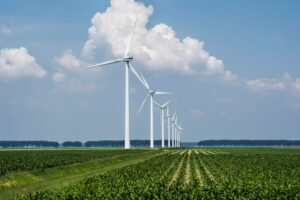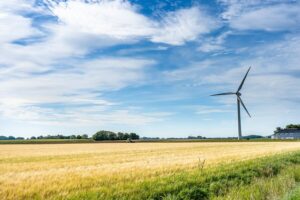Unlocking the Potential of Wind Turbines: Exploring the Cutting-Edge of Wind Energy

Wind turbines are a significant source of renewable energy in the world today. They are responsible for generating clean and sustainable electricity, which helps reduce emissions and our reliance on non-renewable sources. In this blog article, we will explore the potential of wind turbines, their benefits, and the cutting-edge of wind energy.
What are Wind Turbines?
Wind turbines are large machines that generate electricity by using the power of the wind. They are typically tall towers with blades that rotate when the wind blows, creating kinetic energy. The kinetic energy is then converted into electricity and sent to the electrical grid to be used by consumers.
The size and design of wind turbines vary depending on their location and the type of electricity they generate. Smaller turbines are often found in residential areas, while more giant turbines are used in commercial and industrial settings.
Wind turbines typically have three main components: the blades, the generator, and the tower. The blades, usually made from lightweight composite materials, are designed to capture the wind and turn it into kinetic energy. The generator is responsible for converting the kinetic energy into electricity, and the tower supports the blades and generator.
Benefits of Wind Turbines
Wind turbines are a great renewable energy source that can help reduce our reliance on non-renewable sources. They are clean and sustainable, and they produce no emissions or waste. Additionally, they are relatively inexpensive to install and maintain, making them an attractive option for many businesses and homeowners.
Wind turbines can also help create jobs in the renewable energy industry. As more people install wind turbines, more people are needed to manufacture, install, and maintain them. This can have a positive effect on the local economy, as well as the global economy.
Wind turbines can also be used to generate electricity in remote locations that don’t have access to traditional power sources. This can be incredibly beneficial for those living in remote areas, as it can help to improve their quality of life.
Wind Energy Statistics
Wind energy is one of the world’s fastest-growing renewable energy sources. According to the Global Wind Energy Council, there are now 1,122 gigawatts (GW) of installed wind power capacity worldwide, enough to power over 1.2 billion homes.
Wind energy is also becoming increasingly affordable. In the United States, wind energy costs have dropped by nearly 70% since 2009, making it one of the most cost-effective renewable energy sources.
Additionally, wind energy is becoming increasingly reliable. With advances in turbine technology, wind turbines can now generate electricity even when the wind is not blowing. This means that wind turbines can now be used as a reliable source of electricity, even in areas with lower wind speeds.
Exploring the Cutting-Edge Wind Energy
Wind energy constantly evolves, with new technologies and innovations continuously developing. Here are a few cutting-edge technologies to make wind energy more efficient and cost-effective.
The first is floating turbines. These turbines are placed in the ocean and use the waves’ power to generate electricity. This is an incredibly efficient way to generate electricity, as the waves are constantly in motion, allowing the turbines to generate electricity 24 hours a day.
The second is 3D-printed turbines. 3D-printing technology has revolutionized the wind energy industry, allowing for the production of low-cost turbines that are lightweight and highly efficient.
The third is vertical-axis turbines. These turbines are designed to generate electricity from vertical and horizontal wind directions, making them more efficient than traditional horizontal-axis turbines.
Finally, there are hybrid systems that combine wind and solar energy. These systems are designed to capture the power of both wind and solar energy, allowing for even more efficient energy generation.
Wind Power Generation
Wind power generation is the process of using the power of the wind to generate electricity. This is done using wind turbines, which capture the wind’s kinetic energy and convert it into electricity. The electricity is then sent to the electrical grid, where it is used to power homes and businesses.
Wind power generation is becoming increasingly popular as a clean and sustainable energy source. Additionally, it is relatively inexpensive and easy to install, making it an attractive option for many businesses and homeowners.
Wind Energy Sources
Wind energy is typically generated from two primary sources: onshore and offshore wind farms. Onshore wind farms are usually located on land, while offshore wind farms are in the ocean. Both wind energy sources have advantages and disadvantages but are clean and renewable.
Onshore wind farms are typically cheaper and easier to install, as they don’t require any special equipment or infrastructure. Additionally, they can be located in areas with vital wind resources, making them a great energy source. However, they can be noisy and may hurt the local environment.
Offshore wind farms are typically more expensive to install but offer several advantages. For one, they are located in areas with vital wind resources, making them an efficient energy source. Additionally, they are located in the ocean, so they don’t interfere with local wildlife or disrupt the local environment.
Turbine Technology
Turbine technology constantly evolves, with new designs and innovations developed continuously. The most common type of turbine is the horizontal-axis turbine, which has three blades that spin around an axis. This turbine type is relatively simple and cost-effective, making it a popular option for many businesses and homeowners.
However, several other types of turbines are being developed. These include vertical-axis turbines, which rotate around a vertical axis and are more efficient at capturing wind power. Additionally, there are hybrid turbines, which use horizontal and vertical axes to capture the power of the wind.
Finally, there are advanced turbines that use new technologies to capture the power of the wind. These include wind-sensing turbines, which can change the wind and adjust the blades accordingly, and floating turbines, located in the ocean, which can gain power from the waves.
Wind for Electricity
Wind energy is an excellent renewable energy source that can be used to generate electricity. Wind turbines are typically used to generate electricity, as they can capture the power of the wind and convert it into usable electricity.
Wind energy can be used to generate electricity in several ways. The most common way is through wind farms, which are extensive collections of wind turbines connected to the electrical grid. This allows the electricity the turbines generate to be sent to the grid, which is used to power homes and businesses.
Wind energy can also be used to generate electricity in remote locations that don’t have access to traditional power sources. This can be incredibly beneficial for those living in remote areas, as it can help to improve their quality of life.
Wind Farms
Wind farms are extensive collections of wind turbines connected to the electrical grid. They are typically located in areas with vital wind resources, allowing them to generate more electricity. Additionally, they are often located away from populated areas, as this reduces noise and disruption.
Wind farms are becoming increasingly popular, as they are a great clean and renewable energy source. Additionally, they are relatively inexpensive to install and maintain, making them an attractive option for many businesses and homeowners.
Wind turbines are a great source of clean and renewable energy that can help reduce our reliance on non-renewable sources. They are becoming increasingly efficient, reliable, and cost-effective, and they offer several benefits, including job creation, improved quality of life in remote areas, and reduced emissions.
Several cutting-edge technologies make wind energy even more efficient and cost-effective. These include floating turbines, 3D-printed turbines, vertical-axis turbines, and hybrid systems that combine wind and solar power.
Wind turbines are a potent renewable energy source that can help reduce emissions and our reliance on non-renewable sources. By exploring the potential of wind turbines and the cutting-edge technologies used to make them more efficient and cost-effective, we can unlock the potential of wind energy and help create a cleaner, more sustainable future for all.
